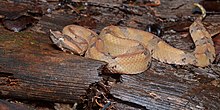Porthidium nasutum
| Porthidium nasutum | |
|---|---|

| |
| Specimen at La Selva Biological Station, Costa Rica | |
| Scientific classification | |
| Domain: | Eukaryota |
| Kingdom: | Animalia |
| Phylum: | Chordata |
| Class: | Reptilia |
| Order: | Squamata |
| Suborder: | Serpentes |
| Family: | Viperidae |
| Genus: | Porthidium |
| Species: | P. nasutum
|
| Binomial name | |
| Porthidium nasutum (Bocourt, 1868)
| |

| |
| Synonyms[2] | |
| |
- Common names: hognosed pit viper,[1] hognosed pit viper,[3] rainforest hognosed pit viper,[4] horned hog-nosed viper.[5]
Porthidium nasutum is a pit viper species found in southern Mexico, Central America and northern South America. No subspecies are currently recognized.[1][3]
Description
[edit]

Adults are usually less than 40 centimetres (16 in) in total length, and rarely more than 60 centimetres (24 in). Females are considerably larger than males. Moderately stout and terrestrial.[4]
Geographic range
[edit]Found in southern Mexico southward through Central America to western Colombia and northwestern Ecuador in South America. Inhabits the Atlantic lowlands from Mexico (Tabasco and Chiapas) through Belize, Guatemala, Honduras, Nicaragua and Costa Rica to eastern Panama and northwestern Colombia. In the Pacific lowlands, it occurs in southwestern Costa Rica, central and eastern Panama, continuing on to northwestern Ecuador. It is found in mesic lowland broadleaf or rainforest from sea level to elevation of about 900 metres (3,000 ft). The type locality given is "Pansos [Panzós], sur les bords du Polochic [Alta Verapaz] (Guatémala)."[2]
Conservation status
[edit]This species is classified as Least Concern (LC) on the IUCN Red List of Threatened Species. It is a widespread and moderately common species that is not facing major threats.[1]
References
[edit]- ^ a b c d Lee, J.; Calderón Mandujano, R. (2007). "Porthidium nasutum". IUCN Red List of Threatened Species. 2007: e.T64344A12772539. doi:10.2305/IUCN.UK.2007.RLTS.T64344A12772539.en. Retrieved 20 November 2021.
- ^ a b McDiarmid RW, Campbell JA, Touré T. 1999. Snake Species of the World: A Taxonomic and Geographic Reference, vol. 1. Herpetologists' League. 511 pp. ISBN 1-893777-00-6 (series). ISBN 1-893777-01-4 (volume).
- ^ a b Porthidium nasutum at the Reptarium.cz Reptile Database. Accessed 22 February 2021.
- ^ a b Campbell JA, Lamar WW. 2004. The Venomous Reptiles of the Western Hemisphere. 2 volumes. Comstock Publishing Associates, Ithaca and London. 870 pp. 1500 plates. ISBN 0-8014-4141-2.
- ^ Brown JH. 1973. Toxicology and Pharmacology of Venoms from Poisonous Snakes. Springfield, Illinois: Charles C. Thomas. 184 pp. LCCCN 73-229. ISBN 0-398-02808-7.
Further reading
[edit]- Bocourt, M.F. 1868. Descriptions de quelques Crotaliens nouveaux appartenant au genre Bothrops, recueillis dans le Guatémala. Annales des sciences naturelles, Series 5, 10: 201–202. ("Bothrops nasutus n. sp.", p. 202.)
External links
[edit]- Porthidium nasutum Archived 2011-07-12 at the Wayback Machine at Honduras Silvestre Archived 2010-03-15 at the Wayback Machine. Accessed 12 February 2008.
- IUCN Red List least concern species
- Porthidium
- Snakes of North America
- Snakes of Central America
- Snakes of South America
- Reptiles of Belize
- Reptiles of Colombia
- Reptiles of Costa Rica
- Reptiles of Ecuador
- Reptiles of Guatemala
- Reptiles of Honduras
- Reptiles of Mexico
- Reptiles of Nicaragua
- Reptiles of Panama
- Least concern biota of North America
- Reptiles described in 1868
- Taxa named by Marie Firmin Bocourt

